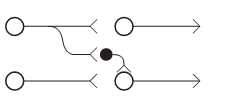Feedforward
In the Feedforward circuits which are as shown in figure below input neurons begin connections (either excitatory or inhibitory) with cells which are closer to the output (that is, higher order) neurons than themselves. In the feedforward inhibition the lower order cells excite inhibitory interneurons that project forward to dampen the activity of neighboring higher order cells. This outcome in the strongest signals being propagated further. The Feedforward inhibition, in the form of GABAergic interneurons, is responsible for creating the surround inhibition seen in sensory pathways, and might also contribute to selective attention, the capability to attend to one stimulus in preference to others

A special situtaion of feedforward inhibition is the enhancing of a reaction by attenuating an opposing action, a mechanism termed as reciprocal inhibition. This operates in spinal cord reflexes which time the activities of limb flexors and extensors. Here, the inhibitory interneurons decrease the activity of the extensor muscles during flexion and vice versa.